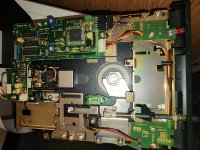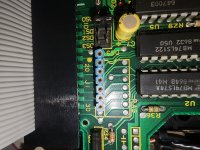ElectroArc
Experienced Member
Hello all,
I'm a little new here, so please excuse me if I've posted this in the wrong place.
If at all helpful, the PC specs are:
160MB PC100 RAM
128gb SSD via a sata to ide adapter
Pentium 3 600MHz
Windows 98
Recently I got a Fujitsu M2551A marked as untested, but took a chance because they're supposedly reliable and worth repairing. Putting it in my then Windows XP computer, all things seemed well. Until I wasn't able to read floppy's, or even format them.
To check on things further, I installed windows 98, copied over ImageDisk, and ran some diagnostics.
Testing RPM is a bit odd, as the diskette just spins for a few seconds with near 0 info on screen, before kicking me back to the main menu.
The alignment test is also really odd, as it will read nothing but "?" no matter what I seem to do.
To ensure parts were actually moving, and not seized up, I opened the shroud so I could see things running inside. At a quick glance there don't appear to be any mechanical problems or physical damage.
I'll attach a picture of the alignment test, and the drive.



Perhaps I have the jumpers configured wrong? I really can't find ANY documentation on this drive, so any help is greatly appreciated!
I'm a little new here, so please excuse me if I've posted this in the wrong place.
If at all helpful, the PC specs are:
160MB PC100 RAM
128gb SSD via a sata to ide adapter
Pentium 3 600MHz
Windows 98
Recently I got a Fujitsu M2551A marked as untested, but took a chance because they're supposedly reliable and worth repairing. Putting it in my then Windows XP computer, all things seemed well. Until I wasn't able to read floppy's, or even format them.
To check on things further, I installed windows 98, copied over ImageDisk, and ran some diagnostics.
Testing RPM is a bit odd, as the diskette just spins for a few seconds with near 0 info on screen, before kicking me back to the main menu.
The alignment test is also really odd, as it will read nothing but "?" no matter what I seem to do.
To ensure parts were actually moving, and not seized up, I opened the shroud so I could see things running inside. At a quick glance there don't appear to be any mechanical problems or physical damage.
I'll attach a picture of the alignment test, and the drive.



Perhaps I have the jumpers configured wrong? I really can't find ANY documentation on this drive, so any help is greatly appreciated!

